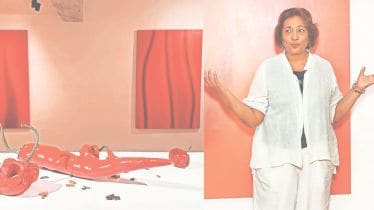Red. Yellow. Blue. The shiny gleam of dried red chilli, the dusty halo of turmeric powder, the textured rustle of papyrus sheets. These are the colours and textures that once lived in our homes, spread across sun-baked terraces where grandmothers dried spices, or hidden in fathers’ studies where the crackle of paper became its own music. Walking into Chromatic Currents, Kumari Nahappan’s exhibition at Pristine Contemporary in New Delhi, you will find those fragments of memory rushing back.
Nahappan, a Singapore-based artist of Indian origin, has built a career turning the ordinary into the monumental. The exhibition, curated by John Tung, reveals how colour is not simply a pigment in her universe, but a force that binds together material, myth, and memory.
From kitchen spice to bronze monument: The power of sensory memory
At the heart of the show are her sculptures of chillies, cast in bronze, sculpted in Thailand, then burnished with patina so intense it feels as if fire itself has been trapped in metal. Named Baby Asana, it lies on its side, curving crisply, inviting the impulse to snap it open between the fingers and scatter its imagined seeds. Another, two chillies entwined, stands upright on a pedestal like tango dancers caught in embrace.
Nahappan traces these images back to her childhood. “The work I do is inspired from my childhood,” she says. Though she seldom visits India, the land of her grandparents, she carries its sensory memories intact. That sensory inheritance surfaces here, transformed into a bright metaphor.
New visual languages: Colour as a force for ritual and reinvention
The exhibition extends beyond spices into new visual languages. In one corner rests a chessboard, its pawns and bishops shaped as playful hybrids of vegetables and vessels, all lacquered in glossy red and cream. The game of strategy, staged through organic forms, hints at negotiations between tradition and modernity, play and ritual, the personal and the cosmic. On the walls, 48’ by 24’ papyrus canvases titled Cardinal drenched in blue pulse with quiet melancholy. “That’s the colour I chose,” Nahappan says. “That’s what I felt during Covid times, I just painted in blues.”
Curator John Tung, who has known the artist for almost a decade, frames the exhibition as a meditation on colour’s ability to shape experience. Quoting the curatorial statement: “Colour in its myriads of mutations is one single element that binds seemingly unrelated objects into one whole.” For Tung, Nahappan’s works are not static objects but forces that vibrate across cultural and cosmic registers, a bridge between the sacred and the everyday.
What makes this return to India especially poignant is the artist’s own story of reinvention. She began her career late, at 37, stepping away from the secure path of providing for necessities to take the uncertain leap into art. Now 72, she speaks of her practice as an act of perpetual youth. “I feel like I’m a girl under 20, instead of 72, because my work energises me,” she adds.
